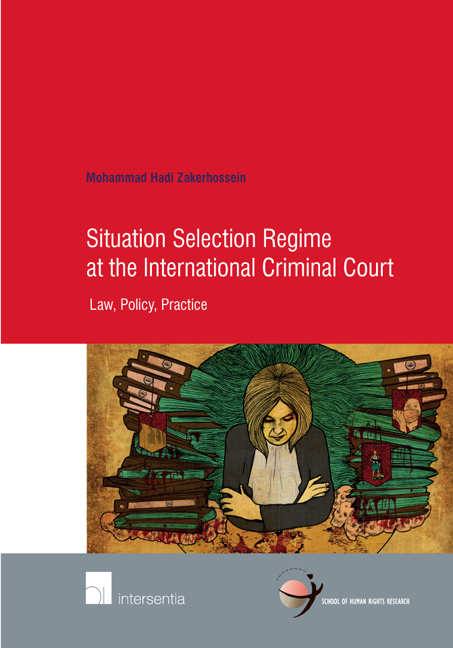Book contents
- Frontmatter
- Contents
- Acknowledgment
- Abbreviations
- General Introduction
- Part One Formulating the Concept of Situation in the Rome Statute Sense
- Part two Situation Selection Process
- Part three Situation Selection Criteria
- Chapter I Jurisdiction
- Chapter II Admissibility
- Chapter III Interests of Justice
- Part Four Situation Selection In Light Of Expressivism
- Conclusion
- Bibliography
- ICC Case Tables
- OTP Documents
- About the Author
- School of Human Rights Research Series
Chapter II - Admissibility
from Part three - Situation Selection Criteria
Published online by Cambridge University Press: 13 October 2018
- Frontmatter
- Contents
- Acknowledgment
- Abbreviations
- General Introduction
- Part One Formulating the Concept of Situation in the Rome Statute Sense
- Part two Situation Selection Process
- Part three Situation Selection Criteria
- Chapter I Jurisdiction
- Chapter II Admissibility
- Chapter III Interests of Justice
- Part Four Situation Selection In Light Of Expressivism
- Conclusion
- Bibliography
- ICC Case Tables
- OTP Documents
- About the Author
- School of Human Rights Research Series
Summary
The second statutory requirement that should be met before initiating an investigation into a situation is the admissibility. Article 17 of the Rome Statute is the legal and statutory framework for applying the admissibility test. According to Paragraph 1 of this article, “the Court shall determine whether a case is inadmissible where: a) the case is being investigated or prosecuted by a State which has jurisdiction over it, unless the State is unwilling or unable genuinely to carry out the investigation or prosecution; b) the case has been investigated by a State which has jurisdiction over it and the State has decided not to prosecute the person concerned, unless the decision resulted from the unwillingness or inability of the State genuinely to prosecute; c) the person concerned has already been tried for conduct which is the subject of the complaint, and a trial by the Court is not permitted under Article 20, paragraph 3; d) the case is not of sufficient gravity to justify further action by the Court.”
CONCEPTUALIZATION OF ADMISSIBILITY
This section seeks the meaning of the admissibility requirement in the Rome Statute. For this purpose, firstly the distinction between admissibility and jurisdiction is clarified. Next, the functions of the admissibility requirement and its components are addressed, in order to clarify the important role of the admissibility requirement in selecting a situation or a case.
DISTINCTION BETWEEN ADMISSIBILITY AND JURISDICTION
To initiate an investigation or prosecution at the ICC, jurisdiction is a necessary requirement, but it is not sufficient. The Rome Statute distinguishes between jurisdiction and admissibility. The assessment of jurisdiction precedes the admissibility assessment. Admissibility is about the exercise of the Court's jurisdiction rather than its existence. In the PTC's words, “the question of admissibility mainly concerns the scenarios or conditions on the basis of which the Court shall refrain from exercising its recognized jurisdiction over a given situation or case.” Hence, the admissibility is a post-jurisdiction issue.
The difference between admissibility and jurisdiction is better understood by considering the difference between ‘jurisdiction to prescribe’ and ‘jurisdiction to enforce’. At the domestic level, a State has power to legislate for all matters within its territorial domain. Such authority is called ‘jurisdiction to prescribe’ or ‘prescriptive jurisdiction’.
- Type
- Chapter
- Information
- Situation Selection Regime at the International Criminal CourtLaw, Policy, Practice, pp. 201 - 332Publisher: IntersentiaPrint publication year: 2017

